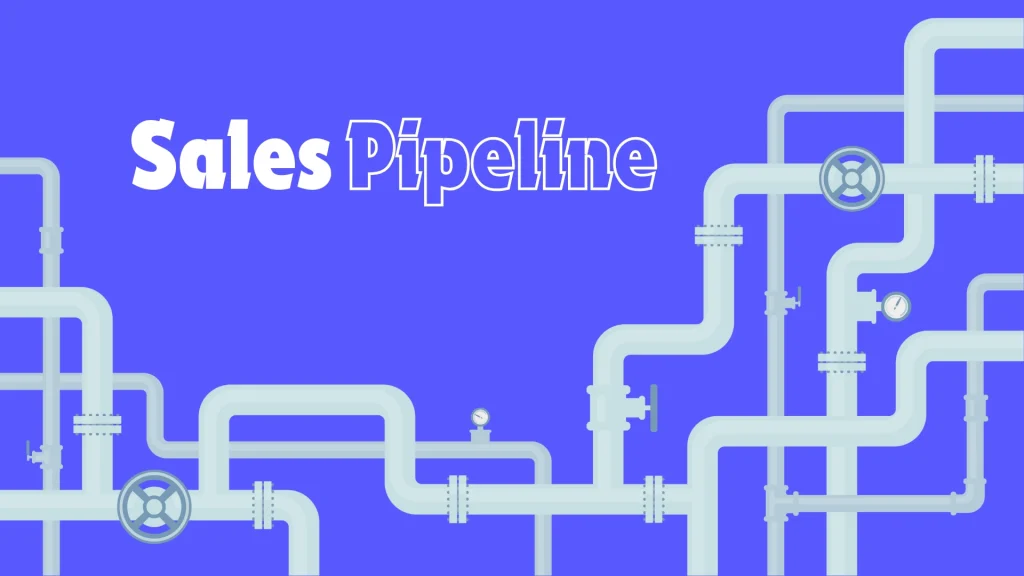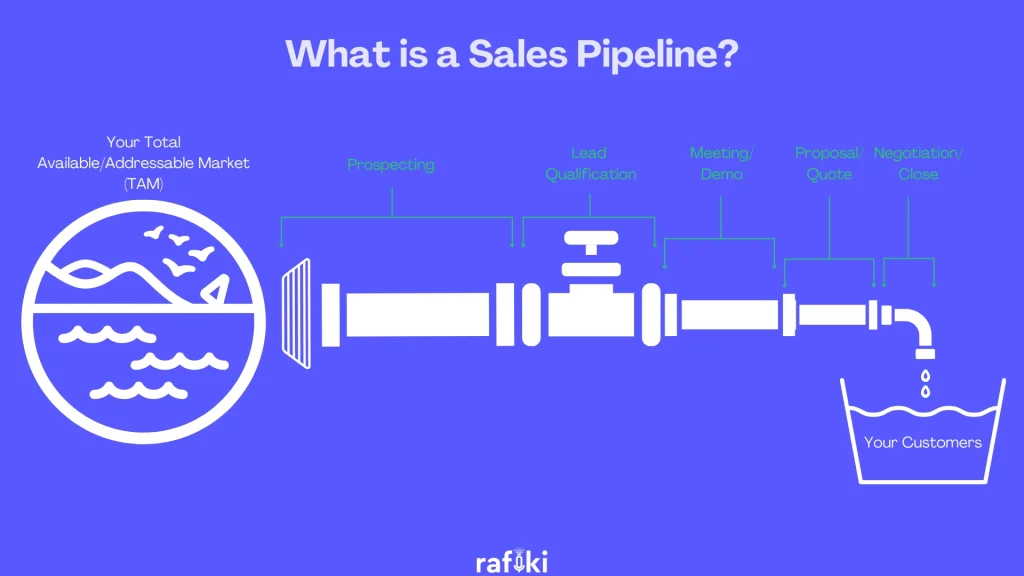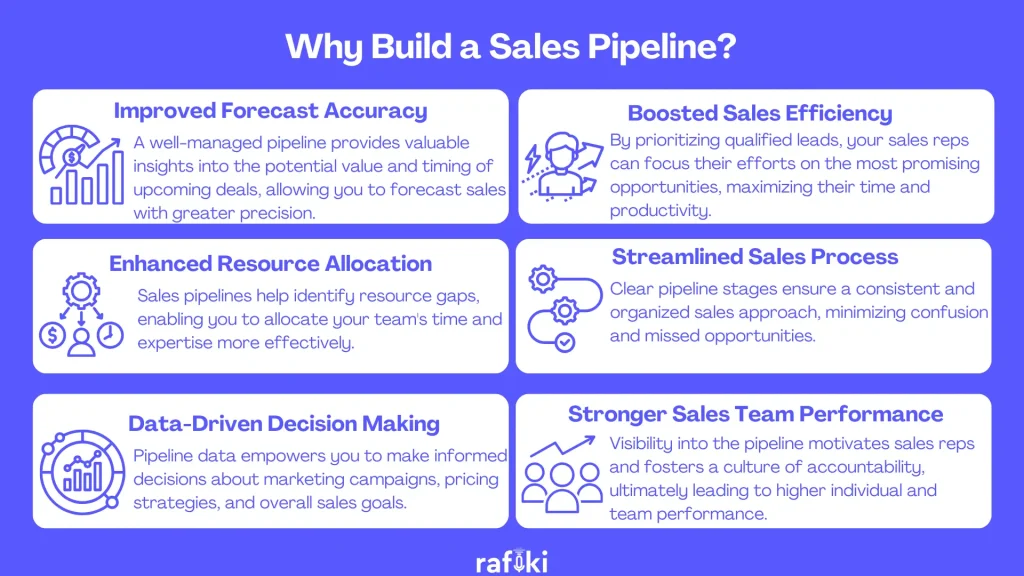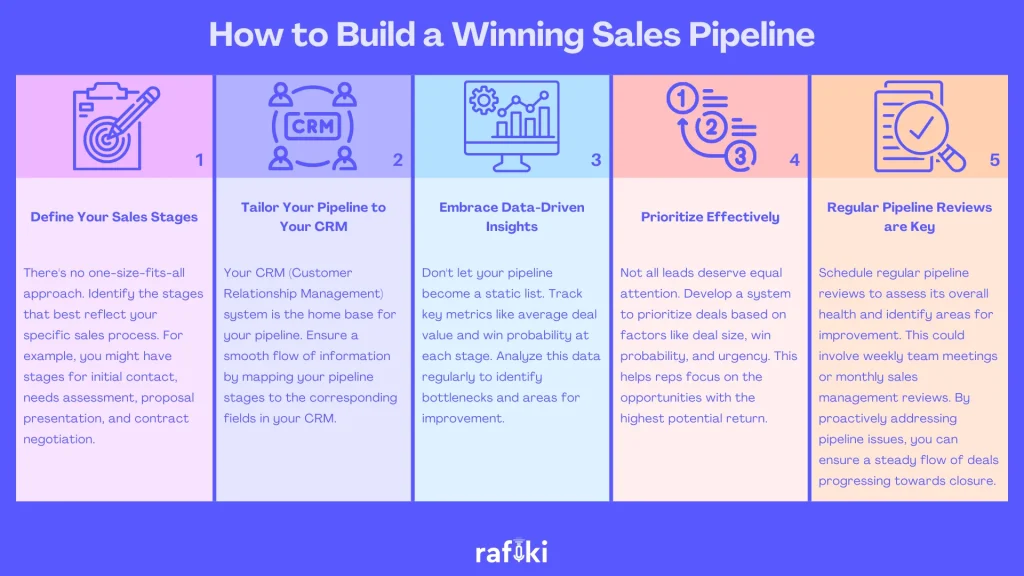Why Rafiki
Pricing


Pricing
Solutions

RevOps Leaders
Synchronize revenue generating functions

SDR Leaders
Get your team aligned and Coach your Reps 3x faster at scale

Sales Leaders
Unlock pipeline truth, drive confident forecasts

A sales pipeline is one of the most fundamental and effective approaches to sales planning and management. Imagine a well-organized pipeline as a visual map of your deals, guiding them from initial prospect outreach all the way to closed-won glory. But what exactly is a sales pipeline, and how can you build one that fuels sales success?
This comprehensive guide will equip you with everything you need to know about building a winning sales pipeline in 2024. Get ready to streamline your sales process, boost forecast accuracy, and close more deals than ever before.
Let's dive in!
In its essence, a sales pipeline is a structured framework that visualizes the journey of your potential customers, from that initial spark of interest to becoming loyal patrons. Think of it as a roadmap that tracks the progress of your deals, allowing you to forecast sales, identify bottlenecks, and ultimately close more deals.

But how exactly are prospects transformed into customers? This is where the magic of your sales pipeline stages comes in. Most pipelines are built around five key stages, each representing a crucial step in the sales cycle:
While the terms "sales pipeline" and "sales funnel" are often used interchangeably, there's a subtle yet important difference between the two. A sales funnel represents a broader view of the customer journey, encompassing all stages from initial brand awareness to the final purchase decision. Think of it as the wide end of a megaphone, capturing a large pool of potential customers.
On the other hand, your sales pipeline focuses specifically on qualified leads who have already expressed some level of interest in your product or service. It's like the narrow end of the megaphone, amplifying the voices of those who are most likely to convert into paying customers. So, by understanding this distinction, you can ensure your sales efforts are targeted towards those with the highest potential for closing deals.

Crafting a sales pipeline that fuels sales success requires careful planning and execution. Here are some actionable steps to get you started:

There's no one-size-fits-all approach. Identify the stages that best reflect your specific sales process. While the five stages mentioned earlier (Prospecting, Qualification, Meeting/Demo, Proposal/Quote, Negotiation/Close) are a common starting point, you may need to add or remove stages depending on your product or service complexity.
Your CRM (Customer Relationship Management) system is the backbone of your sales pipeline. Rafiki's Smart CRM Sync ensures seamless data flow between your pipeline and CRM, keeping all prospect and deal information up-to-date and readily accessible. This eliminates the need for manual data entry, saving your reps valuable time.

Don't let your pipeline become a static entity. Track key metrics like average deal value, conversion rates at each stage, and sales cycle length. Analyze this data regularly to identify trends and bottlenecks. For instance, if you see a significant drop-off between the qualification and meeting stages, it might indicate a need to refine your qualification criteria or improve your demo strategy. Rafiki’s deal intelligence goes beyond just tracking deals, but also competitive and performance analyses, market trends and dynamics to give you a holistic view of every deal in your pipeline.
Not all deals are created equal. Use a prioritization framework that considers factors like deal size, win probability, and urgency. This will help your reps focus their efforts on the opportunities with the highest potential return. With the advancement of AI, it’s imperative to leverage AI to understand and enhance the right deals.
Schedule regular pipeline reviews to assess its overall health and identify areas for improvement. This could involve weekly team meetings or monthly sales management reviews. Ask Rafiki Anything can be a powerful tool here, allowing you to ask insightful questions about your pipeline's performance and get answers instantly. So, by proactively addressing pipeline issues, you can ensure a steady flow of deals progressing towards closure.
Skipping out on sales pipeline management can lead to a number of challenges for your sales team:
Now that you've built a solid sales pipeline foundation, here are some practical tips to keep it running smoothly:
Not all leads deserve equal attention. Use a scoring system that considers factors like budget, decision-making authority, and fit with your ideal customer profile. Focus your reps' efforts on the high-scoring leads most likely to convert.
Sales automation tools can be a game-changer for pipeline management. Utilize features like automated tasks (e.g., sending follow-up emails after meetings) and automated data synchronization to free up valuable selling time.

Just like any good filing system, your pipeline needs regular maintenance. Schedule regular clean-up sessions to remove outdated or stalled deals. So, this ensures your pipeline reflects the most accurate picture of your current sales landscape.
Don't let qualified leads go cold after a single interaction. Keep the conversation going and nudge prospects towards the next step. Invesp says 70% of reps stop at one email, and yet 60% of customers say no four times before saying yes. Clearly, follow ups are not optional.
In conclusion, a well-managed sales pipeline is the cornerstone of a thriving sales organization. So, by implementing the strategies outlined above, you can transform your pipeline from a disorganized mess into a powerful tool for boosting sales efficiency, improving forecast accuracy, and ultimately closing more deals.
Ready to take your sales pipeline to the next level? See how Rafiki can help you streamline the process, automate tasks, and gain deeper sales insights with a free 14-day trial. Sign up today and watch your sales pipeline flourish!
Maximize Your Sales Pipeline